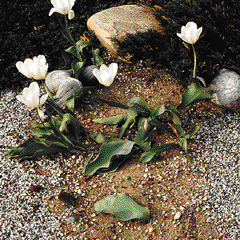
Tulip bulbs produce healthy foliage, but fail to bloom.

Tulip bulbs produce healthy foliage, but fail to bloom.
Healthy tulips may fail to bloom for several reasons.
1. Lack of cooling: To flower properly, tulip bulbs require a minimum exposure of 15 weeks to cool temperatures (40° to 50°F) in fall and winter. Cooling stimulates the embryonic flower stem within the bulb to elongate and emerge from the ground.
2. Foliage removed too soon: After a tulip flowers the remaining foliage continues to manufacture food for new bulbs and flowers for next year.
3. Lack of nutrients: When tulips are grown in infertile soil for more than one season, they form small, poor-quality bulbs. Such bulbs produce only sparse foliage and few, if any, flowers.
4. Undersized bulbs: Bulbs smaller than 2½ inches in circumference may not contain an embryonic flower. They will produce only foliage for 1 to 2 years, until they are large enough to produce a flower.
5. Old plantings: Tulip flowers are largest and most prolific the first spring after newly purchased bulbs have been planted. After flowering, the original bulb usually disintegrates and several small "daughter bulbs" form. Often these daughter bulbs are too small to provide many flowers. Depending on the variety, a planting of tulips generally continues to flower for only 2 to 4 years, each year producing fewer flowers. Tulips are especially short-lived in warm-winter areas (zones 9 and 10; see Plant Climate Zone Map for zone map).
The numbered solutions below correspond to the numbers in the analysis.
1. In warm-winter areas (zones 9 and 10), precool bulbs before planting, or buy precooled bulbs. For details on cooling bulbs, see Tulipa. Postpone planting until mid-December.
2. Let foliage turn yellow before removing it.
3. Add fertilizer when planting, after the new leaves appear on the plants in the spring, and again after they bloom. For details on fertilizing, see Tulipa.
4. Purchase only large, healthy bulbs from a reputable nursery or mail-order company.
5. Replace old tulips with fresh bulbs. You may also dig up, separate, and replant old bulbs. However, it will often be at least 1 year before they will flower again. Unless your soil and climate conditions are ideal for growing tulips, the bulbs and flowers will never be as large and prolific as they were the first year. You can prolong the flowering life of a tulip bed by planting the bulbs deeper than usual. Place them 12 inches deep in the soil rather than the usual 6 inches. The soil must be well drained to prevent rot.
Visit Books That Work at http://www.btw.com